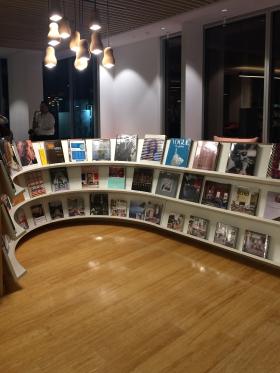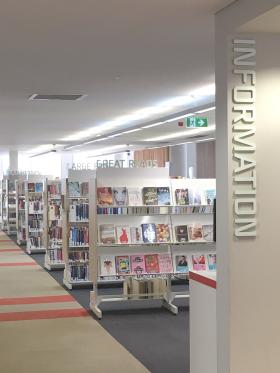Features and considerations: Collection layout
Many libraries are adopting techniques used by bookshops and other retailers to provide user-friendly collections and engaging browsing environments.
Attractive and user-friendly collections
Factors that affect the attractiveness of library collections include:
- organisation of the collection
- breaking up densely housed collections with seating, varied geometries and varied mood
- quality and attractiveness of shelving, shelf signage and shelf ends
- ability to display a range of differently proportioned items attractively and with ease
- density of collection (too many books can be overwhelming – face out books tend to be borrowed more)
- theming of subjects – by creating physical ‘rooms’ for specific subjects, frequently achieved with signage and interior design
- arrangement of shelves and relationship with surrounding furniture and architecture.
Shelving arrangements
Shelving arrangement has a significant influence on the appeal of library collections, the internal ambience of a library and the user experience. As with furniture, shelves can be used to define spaces and create ‘rooms’ in open plan buildings.

Shelving layouts
Radial arrangement
Creating a circular space in the centre that can be used for seating and provides users with a view of the whole collection from a single point.
Converging, off-axis or scattered arrangement
Shelves can be angled radially to converge at a single point. This can be advantageous for maintaining sight lines from a service desk or to create a focal point or hub within the library. Turning the shelves away from a perpendicular arrangement with the aisles and staggering the location of shelf ends can relieve the unrelenting pattern of collections. Shelves can also run for varying lengths creating interesting interstitial spaces, which can be used for seating or study desks.
Series of rooms
Shelves create semi-enclosed spaces in which furniture can be placed to offer a greater range of seating spaces and assist in browsing. Differentiation of ‘rooms’ by colour, subject etc. can assist with wayfinding.
Perimeter shelving
Shelves are primarily arranged along walls leaving free space in the centre of the room for seating or group activities. Alternatively the perimeter can provide a range of shelving and seating options, activating the edges of the building. This works well in buildings with limited outlook or in narrow rooms or corridors where the central space is a thoroughfare.
Well-designed shelving units and the display of items also significantly impact upon the attractiveness of library collections from the user’s perspective. While units may be flexible and mobile, the design of the shelf ends, top and lowest shelf, can bring a sense of permanence, even with castors below.
Shelving and shelf displays
The provision of appropriate and well-designed shelving is one of the most important components of a library building. It impacts directly upon the collections and services of the library and for users, is one of the most important features of their library visit. Good shelving will result in higher levels of resources on loan.
In most contemporary public libraries, adjustable steel shelving is a standard item although there may be times when custom-built shelving is required. The shelving can be colour coded, modular, and ‘dressed’ with end panels and canopies to enhance the appearance and to assist users in locating resources. There is an increasing trend towards shelving with no top canopy which increases the visual openness of the collection area. Conversely a fully framed aesthetic to the shelves can bring a sense of permanence even to mobile shelving (shelving on castors).
Issues to consider
Shelving can be attached to the wall but is generally freestanding.
Consider wall shelving as custom joinery, perhaps integrated with display, desking and seating, to add to the architectural quality of the space.
The recommended height in the adult library is 1600 mm. This height for freestanding shelving will facilitate sightlines, supervision and ease of access. In the children’s area the recommended height is 1300 mm, although a maximum of 1550 mm is acceptable.
Shelving on castors can improve the flexibility of use of the collection space and enable collection areas to be easily expanded or contracted depending on use. This has become commonplace in many libraries, particularly near foyer spaces and children’s areas, allowing larger group events and exhibitions to occur.
900 mm is the usual width for shelves, although manufacturers will also supply 600 mm and 1200 mm shelves as standard. Non-standard sizes can be specially manufactured but at an additional cost and longer delivery times.
It is preferable for the lowest shelf to be about 300 mm from the floor for ease of access, although this will reduce the number of shelves that can be accommodated. Alternatively, this dimension can be reduced to 100 mm if the bottom shelf is mounted at an angle so that the books are tilted back 10–20 degrees from the vertical. In this way the spines of the books will be better lit and easier to read.
Aisles between bays of shelves must be generous enough to suit all users and comply with access and mobility building standards. Where the ends of aisles allow for wheelchair turning, the minimum aisle width between shelves is 1500 mm (i.e. the clear space between facing shelves). Dead end aisles should consider a greater dimension of 1540 mm to allow for 180 degree turns.
Shelving accessories
All library shelving manufacturers offer a range of accessories, which enable their basic shelf units to be adapted to store or display other library materials. These accessories include magazine display racks, audiovisual kit shelves, newspaper displays, poster rails, CD and DVD storage, adjustable bookends and signage.
Shelves filled with books are exceptionally heavy, and the floor loading required to support them is considerably higher than normal office floor loadings. As the library’s layout may change it is wise to construct all library floors with the same loading to promote flexibility.
Compactus shelving
Compactus shelving is mounted on rails allowing the shelves to be moved to provide access. Space is saved due to the elimination of permanent access aisles. Compactus shelving is not appropriate for general public access library collection shelving. It can however, successfully maximise the storage that can be provided, for instance, for the stack. Compactus storage floor loading requirements vary from one installation to another, depending on the type of shelving system, its capacity and the nature of the materials stored, but is considerably higher than normal floor loadings. A structural engineer in consultation with library/council staff must assess floor loadings.
Other types of shelving
Considerable change has occurred in the way that public libraries market themselves which includes the presentation of collections. Even the standard steel shelf can be dressed up in various ways to make the display more attractive. Apart from standard shelving, there are numerous other shelving options which can add variety or be used as feature elements. Collection items can also be displayed more prominently using techniques from bookshops and retail environments.
Shelving options include:
Free standing benches
Provide a convenient surface for users to browse at whilst standing. Face up displays and stacks of books, sometimes multiple copies of the same book, easily captivate people walking past. They can be effective if placed near the entrance as is often seen in bookshops. The low height retains clear sight lines.
Face-out shelving units
Often built-in as feature walls but achievable with standard shelves; sometimes extended to ceiling height for maximum visual impact (though access should be considered) works well for magazines, children’s books, CDs and DVDs. Any inaccessible shelves up high could be used to display non-loan items or old issues for visual uniformity. It is possible to incorporate clear plastic lids containing a cover image, which is especially useful for magazine display.
Novelty display shelves
Custom-designed or individually sourced to provide a variety of shapes, colours and sizes. Can be fixed, on wheels, or built in as part of the architecture. Effective for the display of new books, ‘great reads’, quick read collections and niche collections.
End panels
Can incorporate computer terminals for catalogues – but be aware there have been some rather clumsy attempts at this. Also consider interspersing small workstations along the length of shelves.
Soft cable power
This way, lighting is provided by the shelf unit rather than from the ceiling. Particularly relevant to areas with high ceiling space.
Shelving as space dividers and space identifiers
Large pieces of free-standing joinery, which can create smaller enclosures in a large room. They can have integrated seats, openings, niches etc. and may combine both face out and spine out displays. These are often popular for children’s areas, where they can be highly imaginative and playful, assisting in creating an exciting and educational space. Consider if space dividers, although large, can be relocatable or on castors as fixed furniture can limit the use of space or its rearrangement. If not on castors, consider carrying floor finishes through underneath these items to allow spaces to more easily adapt to change.
Creating engaging displays
The following are some strategies for creating engaging displays.
Placement
Items displayed at eye level, near the entrance, or in areas of high traffic such as at the ends of aisles attract the most attention. Use these locations to ‘sell’ the items people want – popular books, new items etc. Entrances and circulation spaces are great places to put feature shelves and island benches. Aisle ends are conducive to small display units, which in various guises, can display face-out books and carry aisle signage. Integral customised display niches for end panels or perspex poster holders can provide easily changeable displays or signage relating to events.
Presentation
Differentiate special items with the targeted use of colour, signage and lighting on shelves.
Promotion
Inform library users of available resources by using posters, suspended banners, flyers, tags etc. Posters could periodically ‘spotlight’ various collections.
Attaching small tags or notes
Attachments like staff picks to particular books or shelves can also draw attention to them. Book reviews could also be user generated and linked to library social media sites – a great way for people to share ideas with others in the community.
Shelf signage
Shelf signage placed on top of the shelves can be highly visible. As long as shelf height is at the recommended maximum height of 1600 mm for adult collections and 1300 mm for children's collections.
Face-out shelving and display
These are often judiciously located near the main entrance, main circulation areas, or at the entry to aisles. Face-out displays of magazines, CDs, DVDs and talking books are very attractive.
Small shelving display units
These can be added to the ends of shelving aisles. In various guises these are able to display face-out books and carry aisle signage.

Consistent, well-produced signage
While adherence to a methodology of collection signage and display can be frustrating for library staff, the branding and unified appearance of graphics and fitout of a library has become increasingly important.
The professionalism of the library can be reinforced and promoted by well-considered graphics and ensuring that signage is consistent. Avoid hastily printed and ‘sticky-taped’ signage wherever possible.
Consider assistance from a graphic designer to provide a graphic handbook and a series of stationery and signage templates for future use. They are not necessarily difficult to use and contribute significantly to the library’s appearance.